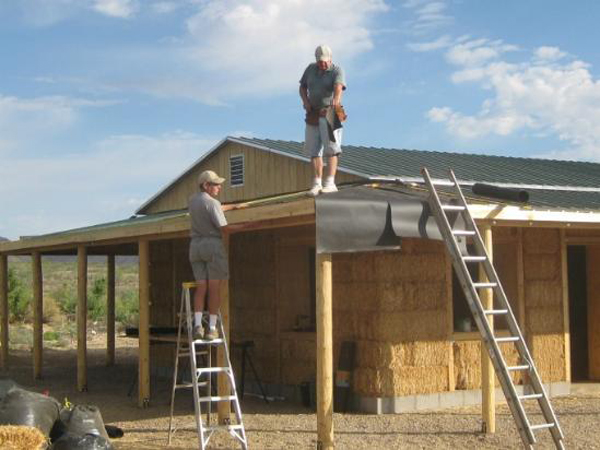
“Climate and weather in the high desert of Arizona are harsh. Granted, we don’t have the severe cold of northern states, but monsoonal rains driven by 50 mph winds and intense sun that will burn skin through a long sleeved shirt can be tough on a building made of straw and adobe clay.
To counter the effects of the wind, we built our house with its back to the prevailing winds from the west and put only one window in the back wall. For rain and sun, we opted for a 360 degree porch or patio. Choose the name you like. Basically it’s an extension of our roof 8’ past the outer wall and floored with flagstone. With this overhang, our adobe plaster walls were protected from all but the most severe driving rains and our windows were shaded from the intense Arizona sun. The overhang also gave us a shady spot out of the wind to enjoy our mountain views any time of day. All good things!”
More at the source: Grit.com
Thanks to Carroll for this tip. This looks like a good magazine like Mother Earth News.

We are designing and engineering a straw bale home in Virginia. The client wants her roof to have one directional slant. This design is simple and cheaper to build but you lose the advantage of extending the roof beyond the exterior walls to create a exterior living space/porch on all but one side. I would love to see more picture of your home. If your willing please forward me a few. Send them to mt1@structur1.com, thanks Darron.
Wrap-around porches would add extra outdoor space in this situation. That would be a good cost effective solution.
I respectfully disagree with own about stacking firewood on a porch.
Firewood is one of the most common transport carriers for termites and carpenter ants.
Firewood should be stacked a distance away from a house. It should be kept dry, well ventilated, and not be stacked directly on the ground.
These practices are almost MANDATORY if someone purchases their firewood from someone else instead of cutting their own from their own land.
Keep in mind that often the first candidate trees for firewood are diseased, dead, or fallen trees. These kinds of trees are the most vulnerable to infestations.
I have made a lot of money over the years repairing the extensive damage these little bugs can cause in peoples’ houses. In almost every case where I have found termite or carpenter ant infestations in a house, firewood was being stacked within a couple of steps from the house.
Obviously the choice is up to each individual homeowner, but I highly recommend building a covered firewood storage shed on an elevated platform at least 20 ft from your house. Those few extra steps to fetch firewood in the winter may seem like an inconvenience, but they are worth it.
Just my opinion.
What you say is best practice. But in cold climates like Colorado it sure is nice having the wood right outside the door plus a big wood bin near the stove. We never had any problems in 12 years or so, but that’s just one person’s experience. Play it safe if in doubt or if you have a nice home.
My fondest memories as a child was driving up to the house my Mother was raised in and smelling fresh baked bread sitting on the porch to cool. Baked in the old style wood stove. My mouth watering for just a bite of it with home made butter. THAT was my first experience with a wrap-around screened in porch. Today I see myself sitting there smoking my pipe with a glass of tea or maybe a cold beer and reflecting on how good it is just sitting there in comfort and just how lucky I am to be there.
Porches are good areas for stacking firewood. The wood will stay dry and be near the stove.
Another great advantage of such porches with posts like that is the ease of creating sun rooms, screened porches, outdoor kitchens, and such.
Also, those posts are great for anchoring a trellis or two to provide even more shade.
Plus, all that additional roof area makes for more rainwater collection potential. Don’t forget those gutters, especially in a desert climate. Rainwater is so superior to well water which often contains salts, hard minerals, and even toxins depending upon what your neighbors have done to contaminate the groundwater.
One note of caution. When constructing a wrap around porch, strap the roof down securely to the posts, and anchor the posts down securely to the ground piers. Wrap around roofs like this catch a great deal of wind. They are notorious for being damaged, destroyed, or completely lost in the wind, if not securely tied down. Take note of all the steel clips and brackets used on this roof featured on this blog post (see the website link Owen provided.) All those brackets are very important to keep porch roofs (and maybe the entire house roof) from flying away in a wind.
Looks like they did a great job.
Good find Carroll, thanks.
In addition, the patios provide important outdoor work areas in many developing countries. This is where people wash clothes and dishes, prepare food, cook (keep heat and smoke outside) dry grain, children play, people socialize, lounge in hammocks, etc. The house can be very small if there’s lots of outdoor living area. Also note, porches are inexpensive and easy to build = good return on investment.